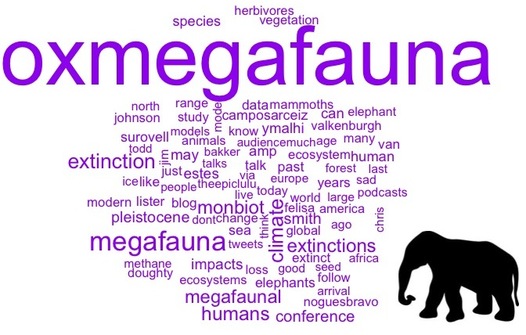
A wordcloud based on the most frequent words associated with the conference on Twitter. I sampled 1500 tweets and show only the terms occurring >20 times. Thanks to the "twitteR" and "wordcloud" packages in R.
This all occurred in the context of a three day conference on megafauna (big animals) that was convened at University of Oxford. The talks imagined a world full of mammoths, lions, bears, and bison. I am, decidedly, not an expert in anything that has to do with animals. But I also recognize that our planet looks the way it does (and may have looked very different in the not so distant past) because of big animals. I think that this knowledge informs my research. Perhaps of equal interest to me is the power of big animals to capture the public imagination. The idea of a world with woolly mammoths draws people to zoos, parks, museums, movies, and books. I think that we are drawn to the idea of a time when humans were not the most dangerous animal on the planet and the conservation implications are interesting to consider.
Monbiot came to Oxford's Natural History Museum to provide a keynote for the conference on why we ought to consider putting big animals back where they belong. He is a masterful speaker. He opens with great energy. He is self-deprecating. He uses the stage well. And he has a way with the words that was the talk of the crowd afterwards. I appreciate the role that he plays in thinking about how to reconnect us with nature.
And as for the most compelling aspect of Monbiot's response to my question about effective science communication? It was the idea of creating an arc in the story that leaves the audience in suspense, so that they wait just a little for the punchline.
 RSS Feed
RSS Feed
